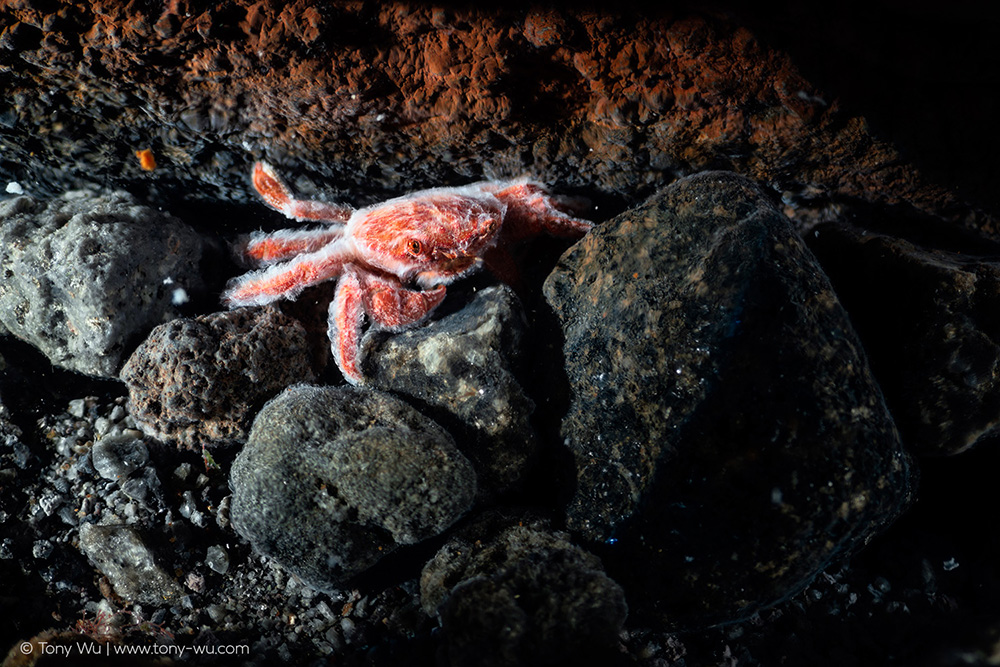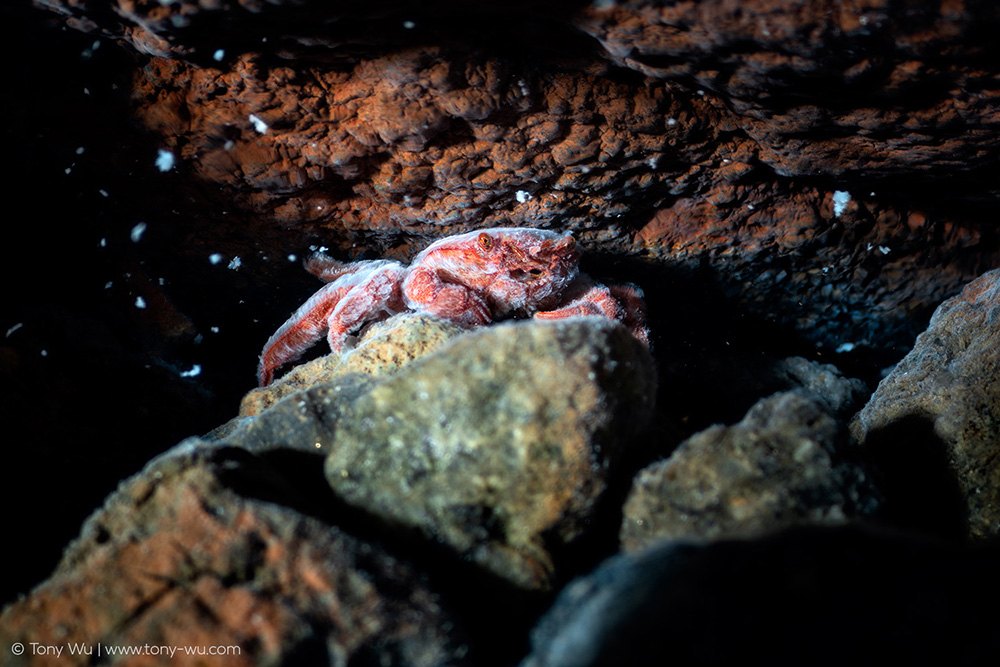Meet Xenograpsus testudinatus:

First described in the year 2000 (1), this species lives in sulfur-rich, anaerobic waters associated with active hydrothermal vents.
Vents are places where there are cracks in the ocean substrate, the result of tectonic activity. Geothermally heated water bubbles up through the sediment.
You might be thinking, "Wait a second. Aren't hydrothermal vents in the super deep sea?"
They are, but not exclusively.
In this instance, the hydrothermal activity is at a small volcanic island in Japan, where hot water percolates up into the ocean. There is a barren zone of a meter ± from the rocky substrate, because most forms of multicellular life don't take well to being bathed in anoxic, acidic water.
This crab however, one of three known species in its genus, thrives in these conditions.
It most likely feeds opportunistically on things that accidentally wander into the inhospitable zone and die, but also via nutrient transfer from symbiotic epsilonproteobacteria and/or gammaproteobacteria (2). Also, see the white, hairy filaments on the crab? Those are growths of anaerobic bacteria, not sure what kind. The crabs might consume these as well.
Diving at the site was an ordeal. We travelled for several hours by fishing boat, only to be met with enormous 3-4m swells (which truly suck when you're only 5-8m down), strong currents and ominous skies to boot.
Having travelled all that way though, I had to give it a try. With the seas stirred up and visibility poor, making it to shallow water took time. We had to swim in from some distance in order not to risk slamming the boat into rocks. I think we only lost our way three times. Once we got to the hydrothermal vent area, swells tossed us back and forth, up and down, round and round.
The crabs were small (thumbnail-size or less). They squeeze-fit into tight, dark crevices in between boulders, spaces that leave little room for humans. Finding accessible crabs took well over 30 minutes.
Wedging myself among rocks and fighting erratic swells, I managed to get a couple of decent photos. The crabs were not fond of light I tried to use for focusing, so I had to do without. Hot water mixing with colder ocean water caused zig-zaggy thermoclines. There were probably haloclines on top of that. The upshot was focus-havoc.
Though I was adequately protected with a thick suit, hood, gloves, etc., I felt the tingling of acidic water, and certainly the elevated temperature. It wasn't enough to be painful or damaging (with limited exposure), but certainly enough for me to understand why I saw no other obvious living thing. Many rocks were stained orange-red by ferrous compounds dissolved in the geothermal upwellings.

By the time we got back to the boat, nearly an hour-and-a-half had passed. There were other people who had travelled with us, a dozen or so. People who had joined with the hope that it would be a pleasant, leisurely outing to dive in calm offshore waters.
Ooops.
I was so excited about finding the crabs that it took me a bit of time to notice that everyone else was lying down. And silent. And pale.
Turns out, everyone had become seasick. And puked. Multiple times for good measure.
We rushed to get everything secured and set out for the long trip back to land.
I hope to get back to the vents at some point, preferably with better conditions. Convincing others to try again might be a challenge though.
_____________________________________
(1) NG, Ngan & Huang, J. F. & Ho, P.H.. (2000). Description of a new species of hydrothermal crab, Xenograpsus testudinatus (Crustacea: Decapoda: Brachyura: Grapsidae) from Taiwan. Natl. Taiwan Mus. Spec. Publ. Ser.. 10. 191-199.
(2) Yang S-H, Chiang P-W, Hsu T-C, Kao S-J, Tang S-L (2016) Bacterial Community Associated with Organs of Shallow Hydrothermal Vent Crab Xenograpsus testudinatus near Kuishan Island, Taiwan. PLoS ONE 11(3): e0150597. https://doi.org/10.1371/journal.pone.0150597